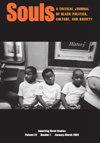Starting Something: Synthesizers and Rhythmic Reorientations in Michael Jackson’s “Billie Jean”
IF 0.1
4区 哲学
Q4 ETHNIC STUDIES
引用次数: 1
Abstract
In 1983, Michael Jackson brought the world to its feet by spinning into the moonwalk while performing “Billie Jean” on live television during the Motown 25 special. In this article, I chart how the analog synthesizers in “Billie Jean” both helped facilitate Jackson's movement towards black futurity and connected him back to black rhythmic histories encapsulated in disco and funk. By unpacking how he moves with and against these synthesizers in the music video and subsequent live performance, I consider the ways in which this relatively new musical technology allowed Jackson to transmit a black queer phenomenology to his audiences.起点:迈克尔·杰克逊《比利·让》中的合成器与节奏调整
1983年,迈克尔·杰克逊在摩城25号特辑的电视直播中表演了《比利·让》,他在月球漫步中旋转,让世界站了起来。在这篇文章中,我描绘了《比利·让》中的模拟合成器如何帮助杰克逊走向黑人未来,并将他与迪斯科和放克中的黑人节奏历史联系起来。通过揭示他在音乐视频和随后的现场表演中是如何与这些合成器配合和对抗的,我思考了这种相对较新的音乐技术是如何让杰克逊向他的观众传递黑人酷儿现象学的。
本文章由计算机程序翻译,如有差异,请以英文原文为准。
求助全文
约1分钟内获得全文
求助全文

 求助内容:
求助内容: 应助结果提醒方式:
应助结果提醒方式:


